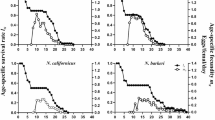Abstract
Although several generalist species of Pergalumna are known to be nematode predators, the potential of oribatid mites as natural enemies of phytonematodes has been underestimated. The objective of this work was to estimate the consumption rate of a Pergalumna sp. when feeding on two major pest nematodes, Meloidogyne javanica and Pratylenchus coffeae, under laboratory conditions. A new method was used, in which live nematodes are offered to mites and subsequently consumption is quantified based on the sclerotized, well preserved structures in the mite’s fecal pellets. The assay was evaluated during 5 days, at 25°C and 96% relative humidity, with three replicates for each nematode species. Every replicate consisted of a group of four mites isolated in an arena, to which 400 nematodes were transferred daily. The daily produced fecal pellets were mounted in Hoyer’s medium for examination under a microscope. The nematode buccal stylets and cephalic frameworks were counted to estimate the number of nematodes consumed. It was estimated that a single mite daily ingested 18.3 ± 0.8 (mean ± SE) M. javanica (J2 juveniles) or 41.6 ± 7.2 P. coffeae (juveniles + adults), the maximal daily consumption being 34 M. javanica and 73 P. coffeae. The method showed to be practical, precise and suitable for laboratory studies in which nematophagous mites classified as engulfers are included.

Similar content being viewed by others
References
Behan-Pelletier VM, Hill SB (1983) Feeding habits of sixteen species of Oribatei (Acari) from an acid peat bog, Glenamoy, Ireland. Rev Ecol Biol Sol 20:221–267
Bilgrami AL (1994) Predatory behaviour of a nematode feeding mite Tyrophagus putrescentiae (Sarcoptiformes: Acaridae). Fundam Appl Nematol 17:293–297
Bilgrami AL (1997) Evaluation of the predation abilities of the mite Hypoaspis calcuttaensis, predaceous on plant and soil nematodes. Fundam Appl Nematol 20:96–98
Coolen WA, D’Herde CJ (1972) A method for the quantitative extraction of nematodes from plant tissue. Sta Ag Res Center, Ghent
Gerson U, Smiley RL, Ochoa R (2003) Mites (Acari) for pest control. Blackwell Science, Oxford
Hooper DJ (1986) Extraction of free-living stages from soil. In: Southey JF (ed) Laboratory methods for work with plant and soil nematodes, 6th edn. HMSO, London
Hussey RS, Barker KR (1973) A comparison of methods of collecting inocula of Meloidogyne spp. including a new technique. Plant Dis Reptr 57:1025–1028
Illig J, Langel R, Norton RA, Scheu S, Maraun M (2005) Where are the decomposers? Uncovering the soil food web of a tropical montane rain forest in southern Ecuador using stable isotopes (15N). J Trop Ecol 21:589–593
Imbriani JL, Mankau R (1983) Studies on Lasioseius scapulatus, a mesostigmatid mite predaceous on nematodes. J Nematol 15:523–528
Muraoka M, Ishibashi N (1976) Nematode-feeding mites and their feeding behaviour. Appl Entomol Zool 11:1–7
Riedel RM, Foster JG, Mai WF (1973) A simplified medium for monoxenic culture of Pratylenchus penetrans and Ditylenchus dipsaci. J Nematol 5:71–72
Rockett CL (1980) Nematode predation by oribatid mites (Acari: Oribatida). Int J Acarol 6:219–224
SAS Institute (1998) User’s manual, version 7.0. SAS Institute, Cary, NC
Scheu S, Falca M (2000) The soil food web of two beech forests (Fagus sylvatica) of contrasting humus types: stable isotope analysis of a macro- and mesofauna-dominated system. Oecologia 123:285–296
Schneider K, Renker C, Scheu S, Maraun M (2004a) Feeding biology of oribatid mites: a minireview. Phytophaga 14:247–256
Schneider K, Migge S, Norton RA, Scheu S, Langel R, Reineking A, Maraun M (2004b) Trophic niche differentiation in soil microarthropods (Oribatida, Acari): evidence from stable isotope ratios (15N/14N). Soil Biol Biochem 36:1769–1774
Symondson WOC (2000) Molecular identification of prey in predator diets. Mol Ecol 11:627–641
Walia KK, Mathur S (1995) Predatory behaviour of two nematophagous mites, Tyrophagus putrescentiae and Hypoaspis calcuttaensis, on root-knot nematode, Meloidogyne javanica. Nematol Mediterr 23:255–261
Walter DE (1988a) Nematophagy by soil arthropods from the shortgrass steppe, Chihuahuan desert and Rocky Mountains of the central United States. Agric Ecosyst Environ 24:307–316
Walter DE (1988b) Predation and mycophagy by endeostigmatid mites (Acariformes: Prostigmata). Exp Appl Acarol 4:159–166
Walter DE, Lindquist EE (1989) Life history and behaviour of mites in the genus Lasioseius (Acari: Mesostigmata: Ascidae) from grassland soils in Colorado, with taxonomic notes and description of a new species. Can J Zool 67:2797–2813
Walter DE, Proctor HC (1999) Mites: ecology, evolution and behaviour. CABI Publishing, Wallingford, Oxon
Walter DE, Hunt HW, Elliott ET (1988) Guilds of functional groups? An analysis of predatory arthropods from a shortgrass steppe soil. Pedobiologia 31:247–260
Walter DE, Kaplan DT, Permar TA (1991) Missing links: a review of methods used to estimate trophic links in soil food webs. Agr Ecosyst Environ 34:399–405
Walter DE, Kaplan DT, Davis EL (1993) Colonization of greenhouse nematode cultures by nematophagous mites and fungi. J Nematol 25:789–794
Weischer B, Brown DJF (2000) An introduction to nematodes: general nematology. Pensoft, Sofia
Winston PW, Bates DH (1960) Saturated solutions for the control of humidity in biological research. Ecology 41:232–237
Acknowledgements
This work was funded by the State of São Paulo Research Foundation (FAPESP 99/04478-3). The technical assistance and provision of nematode populations by Mario M. Inomoto, Melissa D.O. Tomazini, and Sônia R. Antedomenico (Nematology Lab, ESALQ, University of São Paulo) is greatly appreciated. We thank Roy A. Norton for scientific input, Vitalis W. Wekesa for help with statistical analysis and Dave E. Walter for valuable suggestions in the preparation of the manuscript.
Author information
Authors and Affiliations
Corresponding author
Rights and permissions
About this article
Cite this article
Oliveira, A.R., de Moraes, G.J. & Ferraz, L.C.C.B. Consumption rate of phytonematodes by Pergalumna sp. (Acari: Oribatida: Galumnidae) under laboratory conditions determined by a new method. Exp Appl Acarol 41, 183–189 (2007). https://doi.org/10.1007/s10493-007-9062-5
Received:
Accepted:
Published:
Issue Date:
DOI: https://doi.org/10.1007/s10493-007-9062-5




